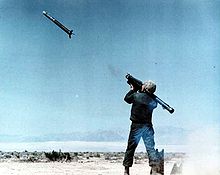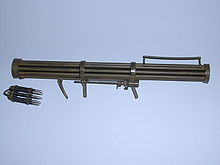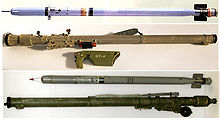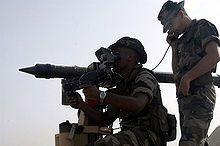- Man-portable air-defense systems
-
Man-portable air-defense systems (MANPADS or MPADS) are shoulder-launched surface-to-air missiles (SAMs). They are typically guided weapons and are a threat to low-flying aircraft, especially helicopters.
Contents
Overview
MANPADS were originally developed in the late 1950s to provide military ground forces protection from enemy aircraft. They have received a great deal of attention as potential terrorist weapons that might be used against commercial airliners. These missiles, affordable and widely available through a variety of sources, have been used successfully over the past three decades both in military conflicts, as well as by terrorist organizations.[1]
They can be purchased on the black market anywhere from a few hundred dollars (USD) for older models to upwards of almost a quarter million dollars for newer, more capable models. Twenty-five countries, including the United States, produce man-portable air defense systems.[2][3] Possession, export, and trafficking in such weapons is officially tightly controlled, due to the threat they pose to civil aviation, although such efforts have not always been successful.[4][5]
The missiles are about 5 to 6 feet (180 cm) in length and weigh about 35 to 40 pounds (18 kg), depending on the model. Shoulder-fired SAMs generally have a target detection range of about 6 miles (10 km) and an engagement range of about 4 miles (6 km), so aircraft flying at 20,000 feet (6,100 m) (3.8 miles) or higher are relatively safe.[6] The acronym MANPADS is commonly mistaken to have a singular form of "MANPAD"—this is incorrect, as even a singular unit is still a system and would have the final S in the acronym.
Missile types
 A FIM-43C Redeye missile just after launch, before the sustainer motor ignites.
A FIM-43C Redeye missile just after launch, before the sustainer motor ignites. Canadian troops wearing CBRN suits training with the Blowpipe missile.
Canadian troops wearing CBRN suits training with the Blowpipe missile.
Unguided
In 1944, Nazi Germany was desperately short of mobile air-defense weapons. Borrowing from the concept of the simple and effective anti-tank Panzerfaust, an unguided multibarreled 20mm rocket launcher, the Fliegerfaust, was developed. The weapon never reached mass production due to the end of World War II.
Following World War II, Soviet designers also experimented with unguided multibarreled rocket launchers but this design concept was abandoned in favor of guided missiles equipped with an infrared sensor.
Infrared
Infrared shoulder-fired missiles are designed to home-in on a heat source on an aircraft, typically the engine exhaust plume, and detonate a warhead in or near the heat source to disable the aircraft. These missiles use passive guidance, meaning that they do not emit signals to detect a heat source, which makes them difficult to detect by targeted aircraft employing countermeasure systems.[7]
First generation
The first missiles deployed in the 1960s were infrared missiles. First generation shoulder-fired SAMs such as the U.S. Redeye, early versions of the Soviet SA-7, and the Chinese HN-5 are considered “tail-chase weapons” as their seekers can only acquire and engage a high performance aircraft after it has passed the missile’s firing position. In this flight profile, the aircraft’s engines are fully exposed to the missile’s seeker and provide a sufficient thermal signature for engagement. First generation IR missiles are also highly susceptible to interfering thermal signatures from background sources, including the sun, which many experts feel makes them somewhat unreliable.[8]
Second generation
Second generation infrared missiles such as early versions of the U.S. Stinger, the Soviet SA-14, and the Chinese FN-6 use improved coolants to cool the seeker head which enables the seeker to filter out most interfering background IR sources as well as permitting head-on and side engagement profiles. These missiles may also employ technologies to counter decoy flares that might be deployed by targeted aircraft and also have backup target detection modes such as the ultraviolet (UV) mode found on the Stinger missile.[6][8]
Third generation
Third generation infrared shoulder-fired SAMs such as the French Mistral, the Russian SA-18, and the U.S. Stinger B use single or multiple detectors to produce a quasi-image of the target and also have the ability to recognize and reject flares dispensed from aircraft.[6][8]
Fourth generation
Fourth generation missiles such as the U.S. Stinger Block 2, and missiles believed to be under development in Russia, Japan, France, and Israel could incorporate focal plane array guidance systems and other advanced sensor systems which will permit engagement at greater ranges.[9]
Command line-of-sight
Command line-of-sight (CLOS) missiles do not home in on a particular aspect (heat source or radio or radar transmissions) of the targeted aircraft. Instead, the missile operator or gunner visually acquires the target using a magnified optical sight and then uses radio controls to “fly” the missile into the aircraft. One of the benefits of such a missile is that it is virtually immune to flares and other basic countermeasure systems which are designed primarily to defeat IR missiles. The major drawback of CLOS missiles is that they require highly trained and skilled operators. Numerous reports from the Soviet-Afghan War in the 1980s cite Afghan mujahedin as being disappointed with the British-supplied Blowpipe CLOS missile because it was too difficult to learn to use and highly inaccurate, particularly when employed against fast moving jet aircraft.[10] Given these considerations, many experts believe that CLOS missiles are not as ideally suited for untrained personnel use as are IR missiles, which sometimes are referred to as “fire and forget” missiles.[11]
Later versions of CLOS missiles, such as the British Javelin, use a solid state television camera in lieu of the optical tracker to make the gunner's task easier. The Javelin’s manufacturer, Thales Air Defence claims that their missile is virtually impervious to countermeasures.[12] Even more advanced CLOS versions, such as the British Starburst, use a laser data link in lieu of earlier radio guidance links to fly the missile to the target.[13]
Laser guided
Laser guided shoulder-fired SAMs use lasers to guide the missiles to the target. The missile flies along the laser beam and strikes the aircraft where the missile operator or gunner aims the laser. Missiles such as Sweden’s RBS-70 and Britain’s Starstreak can engage aircraft from all angles and only require the operator to continuously track the target using a joystick to keep the laser aim point on the target. Because there are no data links from the ground to the missile, the missile cannot be effectively jammed after it is launched. This technique is known as beam riding. Future laser guided SAMs may require the operator to designate the target only once and not manually keep a continuous laser aimpoint on the aircraft. Even though laser guided missiles require relatively extensive training and skill to operate, many experts consider these missiles particularly menacing due to the missiles’ resistance to most conventional countermeasures in use today.[13][14]
Notable uses against military aircraft
- On September 21, 1991, during the Croatian war of independence, a JNA Soko J-21 Jastreb was shot down with a Strela 2M SAM.[15][16]
- During Operation Desert Storm on 17 February 1991 an F-16 was shot down by Strela-3.[17] Russian sources also report about the loss of many military aircraft shot down by the Igla.
- On April 6, 1994, a surface-to-air missile struck one of the wings of the Dassault Falcon 50 carrying three French crew and nine passengers, including Rwandan president Juvénal Habyarimana and Burundian president Cyprien Ntaryamira, as it prepared to land in Kigali, Rwanda, before a second missile hit its tail. The plane erupted into flames in mid-air before crashing into the garden of the presidential palace, exploding on impact. This incident was the ignition spark of the Rwandan Genocide.
- 2002 Khankala Mi-26 crash: On August 19, 2002, a Russian-made Igla shoulder-fired surface-to-air missile hit an overloaded Mil Mi-26 helicopter, causing it to crash in a minefield and burn at the main military base at Khankala near the capital city of Grozny, Chechnya. 127 Russian troops and crew were killed.
- Early in the 2008 South Ossetia War a Polish made Grom MANPADS shot down a Russian Tu-22M strategic bomber. One of its crew members was captured (Major Vyacheslav Malkov), two others were killed and the crew commander is missing in action as of August 2009.[18][19]
Notable uses against civilian aircraft
- The 1978 Air Rhodesia Viscount Shootdown is the first example of a civilian airliner shot down by a man-portable surface to air missile. The pilot of the aircraft managed to make a controlled crash landing, however ten of the survivors were brutally murdered by ZIPRA terrorists.
- Air Rhodesia Flight 827 was also shot down in February 1979 by ZIPRA terrorists armed with a Strela 2 missile. All 59 passengers and crew were killed.
- 1993 Transair Georgian Airline shootdowns involved two separate aircraft shot down a day apart in Sukhumi, Abkhazia, Georgia, killing 108 people.[20]
- 1998 Lionair Flight LN 602 shootdown: On October 7, 1998, the Tamil Tigers shot down an aircraft off the coast of Sri Lanka.
- 2002 Mombasa airliner attack: On November 28, 2002, two shoulder-launched Strela 2 (SA-7) surface-to-air missiles were fired at a chartered Boeing 757 airliner as it took off from Moi International Airport. The missiles missed the aircraft which continued safely to Tel Aviv, carrying 271 vacationers from Mombasa back to Israel. In the photos, the missle systems were painted in light blue, the color used in the Soviet military for training material (a training SA-7 round would not have the guidance system).
- 2003 Baghdad DHL shootdown incident: On 22 November 2003, an Airbus A300B4-203F cargo plane, operating on behalf of DHL was hit by an SA-7 missile, which resulted in the loss of its hydraulic systems. The crew later landed the crippled aircraft safely by using only differential engine thrust by adjusting the individual throttle controls of each engine.
- 2007 Mogadishu TransAVIAexport Airlines Il-76 crash: On March 23, 2007, a TransAVIAexport Airlines Ilyushin Il-76 airplane crashed in outskirts of Mogadishu, Somalia, during the 2007 Battle of Mogadishu. Witnesses claim that a surface-to-air missile was fired immediately prior to the accident. However, Somali officials deny that the aircraft was shot down.
Countermeasures
Man-portable air defense systems are a popular black market item for insurgent forces.[21] Their proliferation became the subject of the Wassenaar Arrangement's (WA)22 Elements for Export Controls of MANPADS, the G8 Action Plan of 2 June 2003,[22] the October 2003 Asia-Pacific Economic Cooperation (APEC) Summit, Bangkok Declaration on Partnership for the Future and in July 2003 the Organization for Security and Co-operation in Europe (OSCE), Forum for Security Co-operation, Decision No. 7/03: Man-portable Air Defense Systems.[23]
Understanding the problem in 2003, Colin Powell remarked that there was “no threat more serious to aviation” than the missiles,[24] which can be used to shoot down helicopters and commercial airliners, and are sold illegally for as little as a few hundred dollars. The U.S. has led a global effort to dismantle these weapons, with over 30,000 voluntarily destroyed since 2003, but probably hundreds of thousands are still in the hands of insurgents, especially in Iraq, where they were looted from the military arsenals of the former dictator Saddam Hussein,[25][26] and in Afghanistan as well. In August 2010, a report by the Federation of American Scientists (FAS) confirmed that “only a handful” of illicit MANPADS were recovered from terrorist caches in Iraq in 2009, according to media reports and interviews with military sources.[27]
Military countermeasures
With the growing number of MANPADS attacks on civilian airliners, a number of different countermeasure systems have been developed specifically to protect aircraft against the missiles.
- AN/ALQ-144, AN/ALQ-147 and AN/ALQ-157 are U.S.-produced systems, developed by Sanders Associates in the 1970s.
- AN/AAQ-24 Nemesis is a NATO system developed by Northrop Grumman and BAE Systems.
Civilian countermeasures
- Civil Aircraft Missile Protection System (CAMPS)—Developed by Saab Avitronics, Chemring Countermeasures and Naturelink Aviation, using non-pyrotechnic infrared decoys.
- Flight Guard by Elta Systems Ltd.
Missile models
- China
- HN-5A/B
- QW-1
- QW-2
- FN-6
- France
- United Kingdom
- Iran
- Japan
- Republic of Korea
- Pakistan
- Poland
- Soviet Union/Russian Federation
- 9K32M 'Strela-2' (SA-7)
- 9K36 'Strela-3' (SA-14)
- 9K38 'Igla' (SA-18)
- 9K310 'Igla-M' (SA-16)
- Sweden
- United States
See also
- Anti-aircraft warfare
- Infrared countermeasures
- Aerial countermeasures
- CAMPS
- Flight Guard
- Northrop Grumman Guardian
References
Portions of this article were taken from Homeland Security: Protecting Airliners from Terrorist Missiles, CRS Report for Congress RL31741, February 16, 2006 by the Congressional Research Service, division of The Library of Congress which as a work of the Federal Government exists in the public domain.
- ^ Footnote 1 in original source (CRS RL31741): “Shoulder-fired SAMs have been used effectively in a variety of conflicts ranging from the Arab-Israeli Wars, Vietnam, the Iran-Iraq War, to the Falklands Conflict, as well as conflicts in Nicaragua, Yemen, Angola, and Uganda, the Chad-Libya Conflict, and the Balkans Conflict in the 1990s. Some analysts claim that Afghan mujahedin downed 269 Soviet aircraft using 340 shoulder-fired SAMs during the Soviet-Afghan War and that 12 of 29 Allied aircraft shot down during the 1991 Gulf War were downed by MANPADS.”
- ^ CRS RL31741 page 1
- ^ Wade Bose, “Wassenaar Agreement Agrees on MANPADS Export Criteria”, Arms Control Today, January/February 2001, p. 1., quoted in CRS RL31741
- ^ MANPADS Proliferation - FAS
- ^ The proliferation of MANPADS - Jane's
- ^ a b c Marvin B. Schaffer, “Concerns About Terrorists With Manportable SAMS”, RAND Corporation Reports, October 1993, quoted in CRS RL31741
- ^ CRS RL31741 page 1-2
- ^ a b c CRS RL31741 page 2
- ^ “Raytheon Electronic Systems FIM-92 Stinger Low-Altitude Surface-to-Air Missile System Family”, Jane’s Defence, October 13, 2000, quoted in CRS RL31741
- ^ Timothy Gusinov, “Portable Weapons May Become the Next Weapon of Choice for Terrorists”, Washington Diplomat, January 2003, p. 2., quoted in CRS RL31741
- ^ CRS RL31741 page 2-3
- ^ “Land-Based Air Defence 2003-2004”, Jane’s, 2003, p. 37., quoted in CRS RL31741
- ^ a b CRS RL31741 page 3
- ^ Richardson, Mark, and Al-Jaberi, Mubarak, "The vulnerability of laser warning systems against guided weapons based on low power lasers", Cranfield University, April 28, 2006
- ^ http://www.avijacijabezgranica.com/jrvudesi.html
- ^ Youtube videoclip
- ^ "Russia's Strela and Igla portable killers". A digital copy of an article from the Journal of Electronic Defense, January, 2004 by Michal Fiszer and Jerzy Gruszczynski. Retrieved: 15 June 2009.
- ^ http://www.fpri.org/enotes/200808.chang.russiaresurgentgeorgia.html
- ^ http://www.mk.ru/politics/publications/331049.html
- ^ Northrop Grumman fact sheet
- ^ "MANPADS at a Glance"
- ^ "G-8 to Take Further Steps to Enhance Transportation Security"
- ^ "Man-Portable Air Defense System (MANPADS) Proliferation"
- ^ "Countering the MANPADS threat: strategies for success.(man-portable air defense systems)"
- ^ "U.S. Expands List of Lost Missiles"
- ^ "Iraq’s Looted Arms Depots: What the GAO Didn’t Mention"
- ^ "Where Have All the MANPADS Gone?"
External links
- MANPADS Proliferation—links to hundreds of documents on MANPADS, their proliferation, and control efforts
- Man-Portable Air Defence Systems (MANPADS) Small Arms Survey Research Note
- Man Portable Missiles vs Airliners
- Are Helicopters Vulnerable?—Analysis of MANPADS effectivness.
- Man Portable AIr Defense System—GlobalSecurity.Org article covering period until 1999.
Categories:- Surface-to-air missiles
- Personal weapons
Wikimedia Foundation. 2010.







